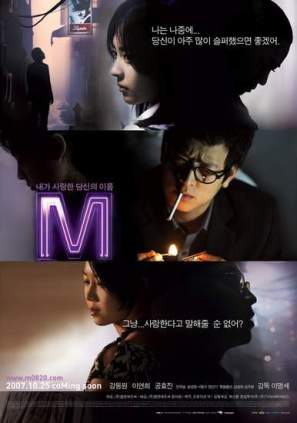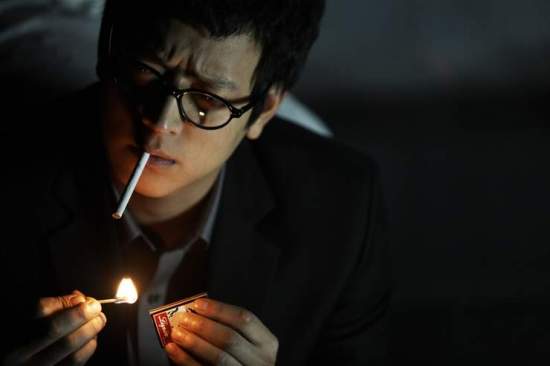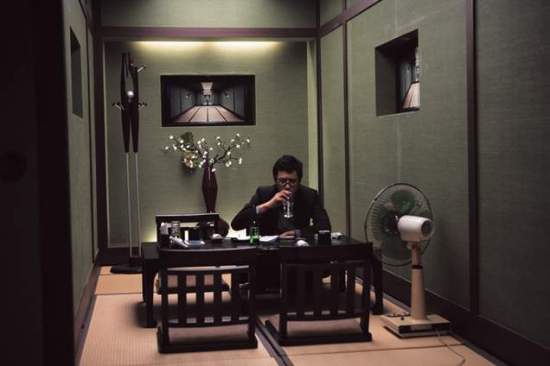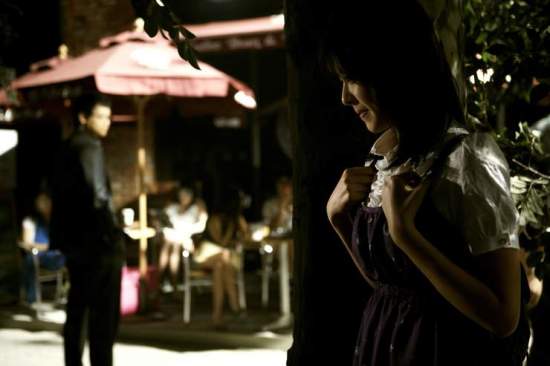Identity and memory are complicated postmodern concepts to convey cinematically. Michel Gondry’s sublime Eternal Sunshine of the Spotless Mind (2004) is perhaps the most renowned mainstream production to interrogate such abstract subject matter, conveying the importance of love, loss and memory as fundamental in the creation and evolution of identity. Without them, Gondry posits, a person will forever be trapped in an identity loop where choices and mistakes are destined to be repeated.
M (M (엠)) also explores such abstract themes and, thanks to artistic auteur Lee Myeong-se (이명세), in a postmodern art-house style. The result is one that instantly polarizes audiences between those with expectations of mainstream conventions and those with an appreciation of art cinema; the former will dislike the absence of structured storytelling and unconventional visualization, while the latter will find enjoyment in the colours, mise-en-scene, and technical innovation.
Min-woo (Kang Dong-won (강동원) is a successful novelist, struggling to write the amazing idea locked within his brain that he can’t fully recall. Plagued by insomnia, Min-woo suffers from hallucinations and stress – when he does sleep, he is hounded by nightmarish dreams. The boundaries between reality and his subconscious blur constantly as Min-woo is confronted by images and scenarios both new and vaguely familiar, all the while stalked by love-stricken Mi-mi (Lee Yeon-hee (이연희). Finally confronting each other in a bar, Min-woo tells Mi-mi his idea but awakes in his apartment with no recollection. Pushing away his faithful wife Eun-hye (Kong Hyo-jin (공효진) with his erratic behaviour, Min-woo attempts to track down the mysterious Mi-mi within the surreal landscape in order to unlock the story seemingly trapped within his subconscious.
The visuals within M are astounding and a testament to the creative flair of Lee Myeong-se, who constructs and frames locations with phenomenal artistic skill. Each venue is masterfully created to portray the wildly different emotions within the subconscious of Min-woo. A street scene, which serves as something of a nexus point within the film, is constructed akin to a Parisian boulevard with the placement of sunlight and the camera filters working in conjunction to convey a beautifully romantic setting, emphasizing the purity of the love Mi-mi exudes despite her stalking. Conversely the employment of shadows and darkness adds genuine horror to scenes within Min-woo’s apartment as insomnia and nightmares take hold, while the alley leading to Lupin’s bar is reminiscent of Ridley Scott’s dystopian Bladerunner (1982).
Similarly the technical prowess within M virtually demands recognition for the innovations displayed. Camera angles and movements allow the audience to experience the disorientation felt by Min-woo, resulting in both having difficulty in perceiving dreams from reality. When Min-woo meets Mi-mi in Lupin’s bar their conversation alternates between moving and still images that capture the moments they share, as if being monitored as well as emulating photographs from a date. The meeting between Min-woo and his agent and later his father-in-law are absorbing as the camera zooms into a painting that emulates the restaurant itself; the painting-within-a-painting becomes a painting-within-a-film-within-a-painting becoming a wonderful visual device that expresses Min-woo’s confused perception.
The focus on artistic and technical merit results in lack of attention on the narrative itself, with the trajectory often not strong enough to link scenes and propel the film forward, instead relying on the suspense and mystery of the visuals to connect scenes. This is unfortunate as the narrative is highly compelling when given attention yet this occurs randomly and infrequently, detracting from the drive for resolution.
This criticism can also be applied to the performances of the central cast, often employed as a focus for the mise-en-scene rather than their acting ability. This particularly applies to Kang Dong-won as Min-woo, as his character is constantly a conundrum due to the various extremes of emotions that he portrays. As such it is problematic to form an empathic bond with him, made more difficult during moments of over-acting. Lee Yeon-hee however is incredibly endearing as Mi-mi, exuding innocence and demure femininity with confidence. Her stalking is cute rather than creepy through her wonderful mannerisms, and her battle with the shadows is full of suspense and horror. Despite the small screen-time given to Kong Hyo-jin, as Min-woo’s wife Eun-hye, she competently portrays an ignored housewife.
Verdict:
M will undoubtedly not appeal to fans of structured mainstream films, with its abstract exploration of memory, loss and identity. For those interested in more artistic and experimental filmmaking, M is a visual tour-de-force with incredible expression of colour and technical confidence. The poignancy of Min-woo’s journey through his subconscious is acute, and serves as a wonderfully thrilling and romantic addition to auteur Lee Myeong-se’s filmography.
★★★★☆





Unfortunately I missed this film when my local Korean Cultural Centre screened it earlier this month… but I am hoping to get to watch it some times soon. You watch a lot of films by the way!
Do you mean the London Korean Cultural Centre? I did this review due to the Lee Myeong-se retrospective, I’m excited for the Q+A.
Yes, the KCCUK in London!
Can’t wait for the Q & A either, now that I’m back in the country (which was the only reason why I missed M), I’m definitely going for the final Lee Myeong-se screening of the Duelist plus Q&A.
I’ll see you there!